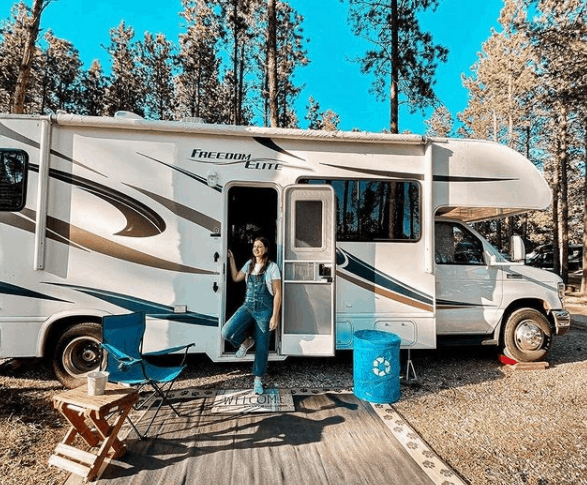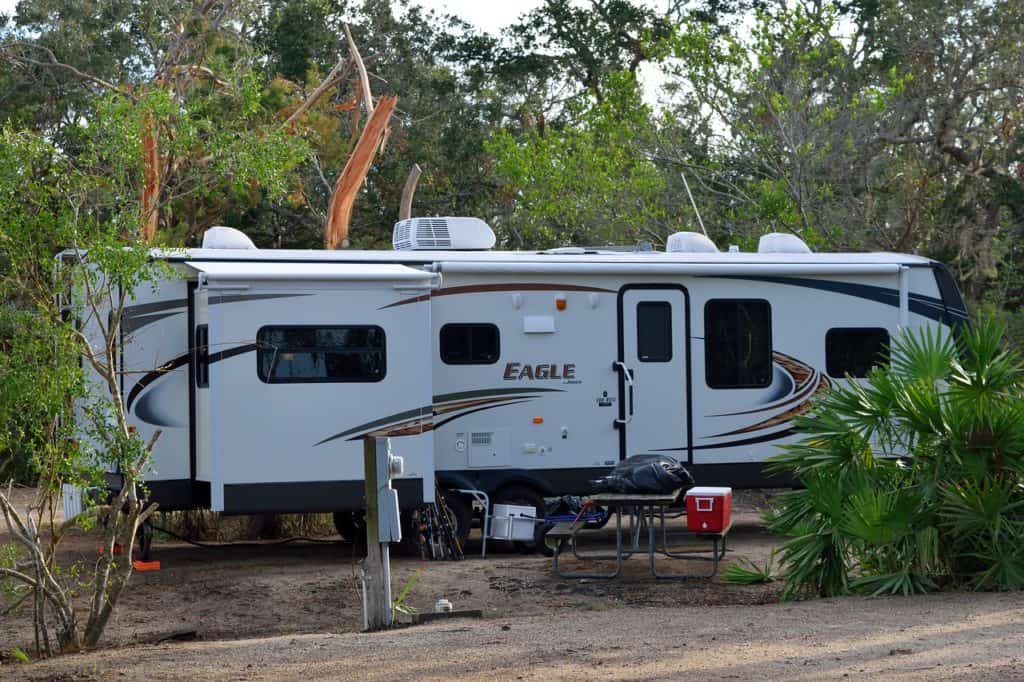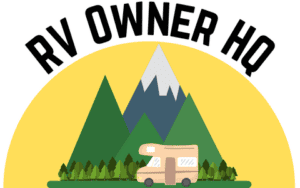Many Americans are beginning to question the “American Dream” of the big house filled with tons of stuff as well as the huge debt and endless work that tends to comes with it.
And instead opting for a simpler life filled with less stuff but more time, freedom, and experiences, by choosing to live in an RV.
But can you really live in an RV and is this type of lifestyle possible for everyone?
The fact that over 1 million Americans are currently living in RVs, proves that anyone can choose to live the full-time RV lifestyle. However, living in an RV does take some getting used to and there are some adjustments that you will have to make. But if you’re willing to make these adjustments a whole new and exciting world of RV living can open up to you.
Even if this full-time RV lifestyle sounds interesting to you though, it can be pretty daunting and overwhelming when trying to figure out how to actually live in an RV full-time.
Because of this, we created this how-to guide that breaks down and explains the most important things you need to know about living in an RV.
How to Live Full-Time in an RV

Choosing the Right RV for Full-Time RV Living
Choosing the right type of RV to live in is an important first step along the journey of full-time RV living. As this decision can have a big impact on how successful you are at RV living.
This can be a complicated and overwhelming decision though for new RVers because of how many different types of RVs there are to choose from today, including class A, B, and C motorhomes, travel trailers, fifth wheels, and truck campers.
So the first thing to do when trying to decide on the type of RV to buy and live in is to learn about all the different types of RVs.
That way you will be able to make a much more informed and better decision when it comes time to purchase an RV for full-time living.
And to get you started on this important first step, we included this super helpful and informative YouTube video, that gives an in-depth explanation of each type of RV as well as some of the pros and cons of each.
Different Types of RVs
https://youtu.be/NPqsVz2OZp0
One of the best ways to choose an RV to live in full-time is to try and imagine what you want your RV life to look like and then choose an RV that will best fit that lifestyle.
It’s important to remember though that nothing is permanent in full-time RV living which is actually one of its great advantages.
So if you decide down the road that a different type of RV might be a better fit for you and your family, you can always make that change in the future.
In fact, it is not uncommon for full-time RVers to start out with one type of RV thinking that it would be the best choice, only to change to a different RV once they gained some experience and had a better idea of what they wanted their RV lifestyle to look like.
Downsizing to Live in an RV
One of the biggest concerns most new full-time RVers have is what am I supposed to do with all of my stuff?
And this is a valid concern as there are some sacrifices you’re going to need to make in regards to the amount of stuff you can have while living in an RV.
Because if you are coming from a 2000 square foot home filled to the gills with stuff, you are going to have to downsize a lot to fit your life into 250 square feet of an RV.
Remember though that it took you a lifetime to accumulate all this stuff, so don’t expect to get rid of everything in an afternoon or even in a few days.
Instead, realize that when you are downsizing to live in an RV, it will be a process that can take weeks or even months to slowly pair down your possessions over time.
So that you can comfortably fit all your possession into an RV.
And if you are struggling with this process of eliminating stuff to live in an RV, remember to take it easy on yourself and remind yourself why you are doing this in the first place.
Living in a Small Space

Another adjustment you will have to make if you plan to live in an RV, is adapting to the smaller amount of living space an RV provides which is usually around 250 square feet or less.
Surprisingly though this transition is usually not that difficult for most people and some actually prefer the smaller living space, because it centralizing everything into one location providing more convenience and less cleaning.
And when you really think about it how much of your house do you really use on a daily basis anyway, I mean when was the last time anyone even went into the dining room or the formal living room.
Working From The Road in an RV
Unless you happen to be the recipient of a huge sum of money from lottery winnings or a trust fund, if you plan to live on the road you will also have to figure out a way to make a living from the road.
Luckily though it has never been easier to work remotely thanks to the internet and the willingness of more and more companies to allow their employees to work remotely instead of in an office.
Also, in today’s gig economy it is very easy to find quick and temporary jobs while traveling on job sites such as Upwork, freelancer, and guru allowing you to work no matter where your RV is parked.
The most important thing to remember though when working and living in an RV is that no one job or type of work is going to be the best fit for everyone.
So you might need to try out a few different options before finding the job that best fits your skillset and aptitude.
Where to Park Your RV While Living In It
There are many options for parking your RV including RV parks, campgrounds, National and State parks, national forest land, and BLM land.
And where you choose to park largely depends on what kind of amenities you need as well as your RV lifestyle.
RV Parks and Campgrounds

If you’re looking for a place to park your RV that offers the most on-site amenities and comforts then you should definitely go with RV parks and campgrounds as they will offer the most amenities and conveniences by far.
As most RV parks and campgrounds will have wifi (typically very slow), public restrooms, and showers, on-site laundry, as well as water and electrical hookups for your RV.
It can get pretty expensive staying in RV parks though, as most usually charge around $40 or more a night.
This means you could spend $1,000 or more a month while staying in RV parks.
And that’s just an average as more expensive resort-style RV parks can charge close to $100 a night.
However, many RV parks due offer monthly or long-term rates especially during their off-season, which can significantly reduce the cost compared to their nightly rate.
National and State Parks
Almost all national parks and many state parks have campgrounds which can be a great place to park your RV if you want to be more surrounded by nature.
And the great thing is, is that national and state parks are usually much cheaper compared to commercial RV parks and campgrounds, often costing as little as $10 or $15 a night.
National and state parks don’t always make the best place to live in your RV though.
Because if you have a job that requires high-speed internet it can be very challenging to find a signal in most national parks.
This means in order to work you would have to drive into town to find somewhere where you could access the internet.
In addition, most national and state parks have limits on the amount of time you are allowed to stay in the campground, meaning that you would have to move more often.
And lastly, while some national parks due offer some hookups, many do not, which means you would need to be completely self-sufficient while staying in many national and state parks.
National Forest and BLM Land
The cheapest place by far to park and live in your RV is national forest and BLM land which are federally managed and protected lands that are entirely free to park and stay on.
However, while staying in a national forest or BLM land is a great way to live cheaply in an RV, be forewarned that these lands and the campsites in them are very primitive and usually offer no hookups or amenities of any kind.
So if you plan to stay on national forest or BLM land you must be prepared to boondock and be completely self-sufficient.
Also, while staying on this type of land it can be difficult to find a reliable cell signal for the internet.
And just like national and state parks, national forests and BLM land do have limits on the amount of time you can stay before you have to leave, which is typically 14 days.
High-Speed Internet While Living in an RV
One of the biggest challenges when living in an RV is trying to find a reliable high-speed internet connection while traveling across the US.
There are, however, several options available to the modern nomad that can provide high-speed internet access regardless of their location.
The first option and the cheapest is to use the free wifi available either at your campground or at a local coffee shop.
However, this method does not always provide the best connection speed and depending on where you’re staying, it might be difficult to find free wifi.
So if you’re planning to live and work full time from the road it’s best to upgrade to your own dedicated high-speed internet access through one of the main cellphone carriers such as AT&T or Verizon.
Both AT&T and Verizon offer an unlimited data plan that provides high-speed internet connection from pretty much anywhere in the US.
However, if you get too far off the beaten path, signal strength can be a real issue.
So if you plan on traveling and living in more remote places in an RV, it’s best to make the long-term investment in a cell booster like this popular one on Amazon from WeBoost.
As a cell booster amplifies the cell signal giving you at least two and maybe even three more bars of signal when your in an area with limited cell phone coverage.
How to Handle Mail and Packages While Living in an RV
The next big hurdle to full-time RV travel is figuring out how to handle and what to do with all the mail you receive every day.
To start with, for most people at least 50% of the mail they receive is junk mail anyway.
Also, by transiting to a permanent RV lifestyle you will just naturally get less mail and fewer bills because you won’t have utility bills every month from the electric, water, and cable company.
But what about the mail you do need, like bank statements, credit card bills, and cell phone bills.
The best thing you can do with this type of mail is to switch to a digital statement or bill option, that would come in the form of an email instead of a paper statement or bill, which almost every bank and company now offers.
For those few other pieces of mail that you might receive, you can easily have that sent to a family member or a close friend that would be willing to receive a few pieces of mail for you occasionally.
And if you don’t want to do that, there are RV clubs like Escapee, that will provide a permanent mailing address to you and then forward your mail to wherever you happen to be at the time, for a monthly fee of about $10.
As far as packages go that you might have shipped to you say from Amazon, most RV parks and campgrounds allow packages to be shipped directly to the campground or even your campsite.
Washing Clothes While Living in an RV
Washing clothes while living in an RV is pretty easy, considering most RV parks have on-site laundry facilities.
And if you’re not staying in an RV park, you can always use a local laundry mat to wash your clothes.
But if you are looking for the ultimate in luxury, when it comes to laundry while living in an RV, you can actually find larger RVs such as class A RVs or fifth-wheel trailers that have washers and dryers built in them.
Where to Find Water and Dump Your Waste
Obtaining fresh water for drinking and washing and finding a place to dump your waste is essential if you plan to live full-time in an RV.
If you’re staying in an RV park these services are a breeze, as RV parks will usually have these connections right at the campsite, allowing you to easily hook into the utilities at the RV park.
If however, you plan to do more boondocking and off-grid living in an RV, these become a little more tricky but certainly not impossible, it will just require a little more effort and work.
To handle water you will have to rely on your RV’s fresh water tank, which means you’ll need to find places to fill those tanks.
The good news though is there are many places you can fill your RV’s fresh water tank including truck stops, gas stations, rest stops, dump stations, forest land, and national and state parks.
However, remember you always need to seek permission before topping off your tank and you might have to pay a small fee.
The best places to dump your waste are either national and state park dump stations or RV park dump stations.
Keep in mind though that you will usually have to pay a few to dump at these locations if you are not camping there.
Another way to handle dumping waste while living in an RV is to not create any in the first place, which can be accomplished by switching to a composting toilet.
Composting toilets like this popular one on Amazon by Nature’s Head are completely self-contained and do not require a blank tank which means you don’t have to worry about finding a place to dump your black tank.
Recent Posts
47 RV Storage Ideas to Maximize Your Space for Compact Living
Camping and living in an RV is an incredible adventure, but it comes with its fair share of challenges, particularly around storage, due to the lack of space. Because of this, it's a must to make...
Are you looking to give your RV a cozy, rustic makeover? If so, farmhouse RV decor is the perfect style to transform your camper into a warm and inviting home on wheels. In this blog post, I'll...

